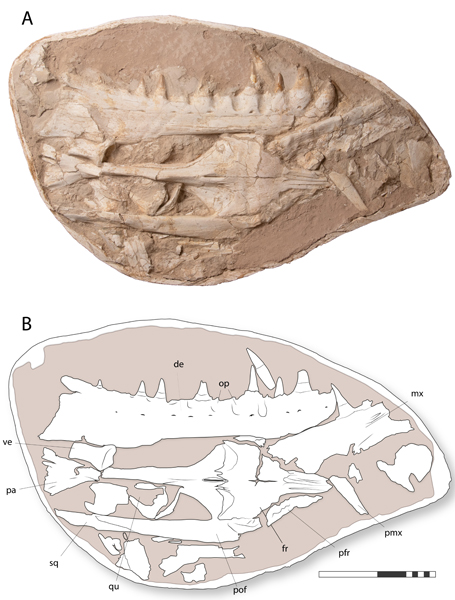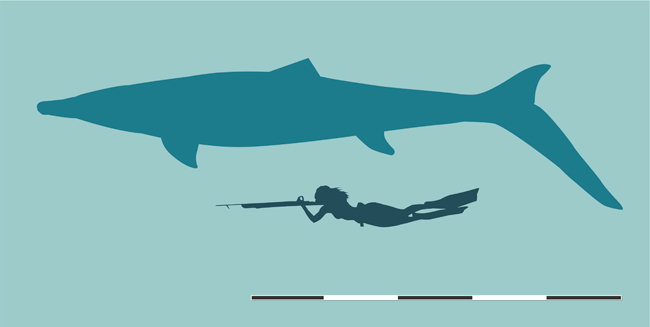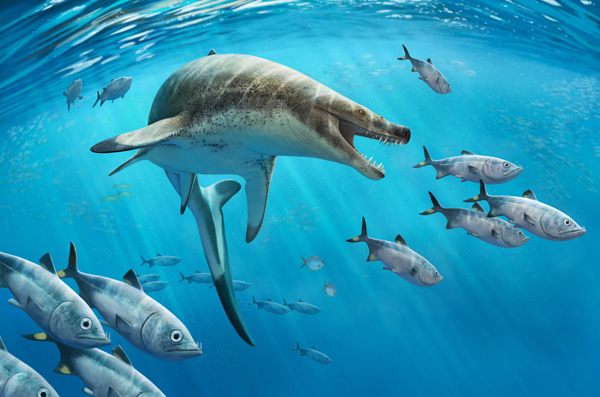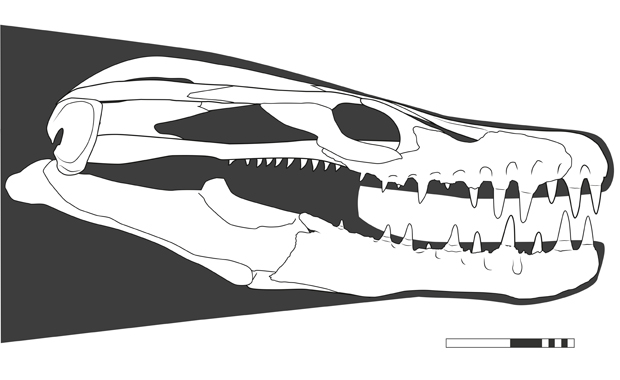Khinjaria acuta A Bizarre New Mosasaur from Morocco
A new mosasaur taxon from the Late Cretaceous of Morocco has been scientifically described. Khinjaria acuta was as long as an Orca (Orcinus orca). It had a robust skull, strong jaws and dagger-like teeth. The researchers contrast today’s marine ecosystems with few apex predators, with the Late Cretaceous marine environment. Writing in the journal “Cretaceous Research” the researchers portray an ancient marine ecosystem teeming with predators.
Khinjaria acuta
The study is based on a skull and parts of the postcranial skeleton collected from a phosphate mine southeast of Casablanca (Morocco). Researchers from the University of Bath, the Marrakech Museum of Natural History, the Museum National d’ Histoire Naturelle (NMNH) in Paris (France), Southern Methodist University in Texas (USA), and the University of the Basque Country (Bilbao) were involved.
Measuring around eight metres in length, Khinjaria used its long, dagger-like teeth to seize prey. It was part of an extraordinarily diverse fauna of predators that inhabited the Atlantic Ocean off the coast of Morocco during the Maastrichtian faunal stage of the Late Cretaceous.

The Sheer Diversity of Top Predators in the Marine Ecosystem
One of the authors of the scientific paper, Dr Nick Longrich (University of Bath), stated:
“What’s remarkable here is the sheer diversity of top predators. We have multiple species growing larger than a great white shark, and they’re top predators, but they all have different teeth, suggesting they’re hunting in different ways.”
Dr Longrich added:
“Some mosasaurs had teeth to pierce prey, others to cut, tear, or crush. Now we have Khinjaria, with a short face full of huge, dagger-shaped teeth. This is one of the most diverse marine faunas seen anywhere, at any time in history, and it existed just before the marine reptiles and the dinosaurs went extinct.”
A Diversity of Moroccan Marine Reptiles
Fossil discoveries have highlighted the astonishing diversity of large marine reptiles in the environment. Their different dentition suggests that many were not directly competing, that niche partitioning was occurring. For example, the researchers conducted a phylogenetic analysis and placed Khinjaria in a mosasaur clade which they named the Selmasaurini. Also placed in this clade was the Moroccan plioplatecarpine mosasaur Gavialimimus almaghribensis. This mosasaur was a specialised fish hunter.
To read Everything Dinosaur’s article about Gavialimimus almaghribensis: A New Species of Mosasaur from Morocco.
Mosasaurs, plesiosaurs and giant sea turtles disappeared, along with entire families of fish at the end of the Cretaceous. This led to the evolution of modern marine ecosystems with whales and seals as apex predators along with teleost fish such as swordfish and tuna.
Dr Longrich commented:
“There seems to have been a huge change in the ecosystem structure in the past 66 million years. This incredible diversity of top predators in the Late Cretaceous is unusual, and we don’t see that in modern marine communities.”

An Ecosystem Different from a Modern Marine Ecosystem
Modern marine food chains have just a few large apex predators, animals like orcas, white sharks, and leopard seals. The Late Cretaceous had many more types of marine predators.
Dr Longrich continued:
“Modern ecosystems have predators like baleen whales and dolphins that eat small prey, and not many things eating large prey. The Cretaceous has a huge number of marine reptile species that take large prey. Whether there’s something about marine reptiles that caused the ecosystem to be different, or the prey, or perhaps the environment, we don’t know. But this was an incredibly dangerous time to be a fish, a sea turtle, or even a marine reptile.”
Professor Nathalie Bardet, (Natural History Museum of Paris), explained:
“The Phosphates of Morocco deposit in a shallow and warm epicontinental sea, under a system of upwellings; these zones are caused by currents of deep, cold, nutrient-rich waters rising towards the surface, providing food for large numbers of sea creatures and, as a result, supporting a lot of predators. This is probably one of the explanations for this extraordinary paleobiodiversity observed in Morocco at the end of the Cretaceous.”.
The phosphate mines of Morocco have provided a wealth of marine fossil material. The specimens collected include the “saw-toothed” mosasaur Xenodens, Stelladens which had teeth with additional cutting edges and Thalassotitan whose teeth were conical in shape and massive.
Everything Dinosaur acknowledges the assistance of a media release from the University of Bath in the compilation of this article.
The scientific paper: “A bizarre new plioplatecarpine mosasaurid from the Maastrichtian of Morocco” by Nicholas R. Longrich, Michael J. Polcyn, Nour-Eddine Jalil, Xabier Pereda-Suberbiola and Nathalie Bardet published in Cretaceous Research.
Take a look at the Everything Dinosaur website: Everything Dinosaur.



